Test Configuration
Here is the basic test configuration that we used:
- Motherboard and CPU: Supermicro X11SDV-4C-TLN2F with Intel Xeon D-2123IT
- RAM: 4x 16GB Micron DDR4-2400 RDIMMs
- SSD: Intel DC S3710 400GB
Supermicro has a number of platforms with the Intel Xeon D-2123IT. After this review, we will likely have a piece on the Supermicro X11SDV-4C-TP8F which is a larger motherboard but we saw similar numbers to what we have here.
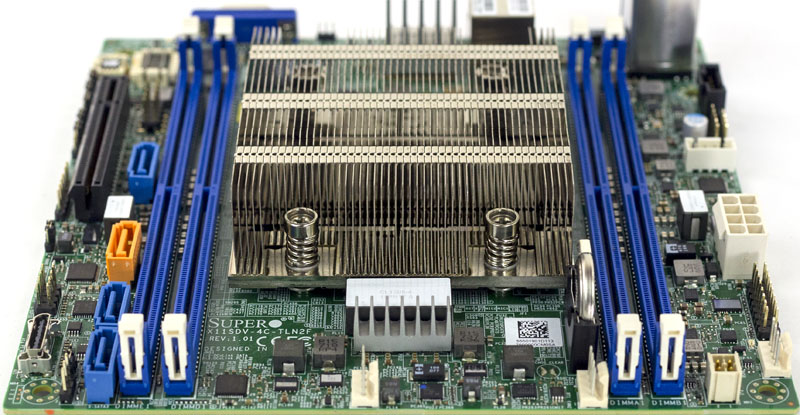
Still, this is a great compact platform for those looking towards a lower-cost Xeon D-2100 experience.
Intel Xeon D-2123IT Benchmarks
For this exercise, we are using our legacy Linux-Bench scripts which help us see cross-platform “least common denominator” results we have been using for years as well as several results from our updated Linux-Bench2 scripts. At this point, our benchmarking sessions take days to run and we are generating well over a thousand data points. We are also running workloads for software companies that want to see how their software works on the latest hardware. As a result, this is a small sample of the data we are collecting and can share publicly. Our position is always that we are happy to provide some free data but we also have services to let companies run their own workloads in our lab, such as with our DemoEval service. What we do provide is an extremely controlled environment where we know every step is exactly the same and each run is done in a real-world data center, not a test bench.
We are going to show off a few results, and highlight a number of interesting data points in this article.
Python Linux 4.4.2 Kernel Compile Benchmark
This is one of the most requested benchmarks for STH over the past few years. The task was simple, we have a standard configuration file, the Linux 4.4.2 kernel from kernel.org, and make the standard auto-generated configuration utilizing every thread in the system. We are expressing results in terms of compiles per hour to make the results easier to read:
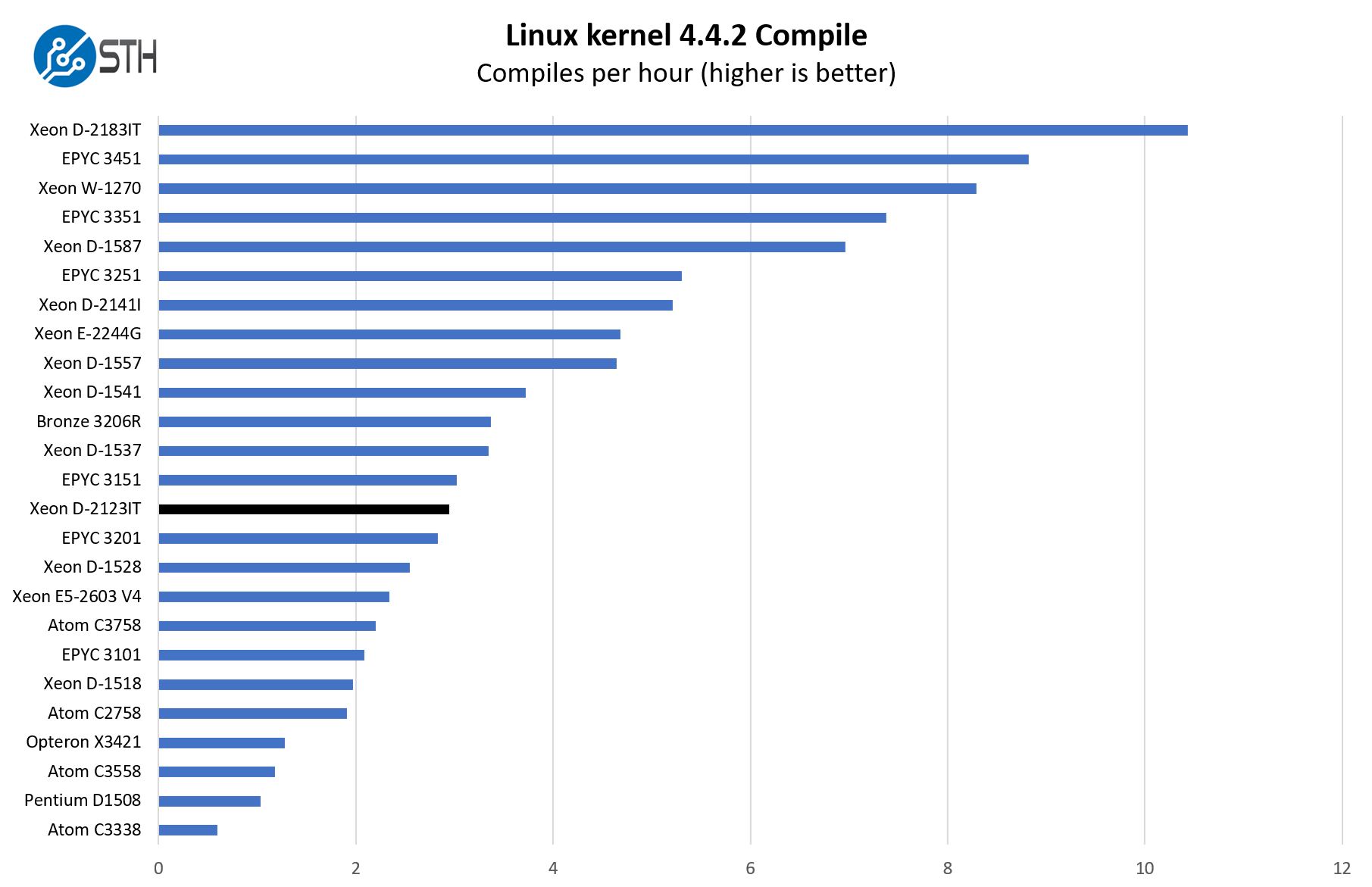
These charts are a bit busy given how many comparisons we wanted to show. Here, we actually wanted to focus on just how big of a gap there is between this CPU and the Intel Xeon D-2183IT in terms of performance. Many systems and motherboard manufacturers design a PCB, then place a number of different Xeon D SKUs to create different performance levels. There are segments of the embedded market that want just single SKUs, but there are others that want to have this flexibility to minimize design cycles while being able to scale performance.
c-ray 1.1 Performance
We have been using c-ray for our performance testing for years now. It is a ray tracing benchmark that is extremely popular to show differences in processors under multi-threaded workloads. Here is our newer Linux-Bench2 8K render to show differences.
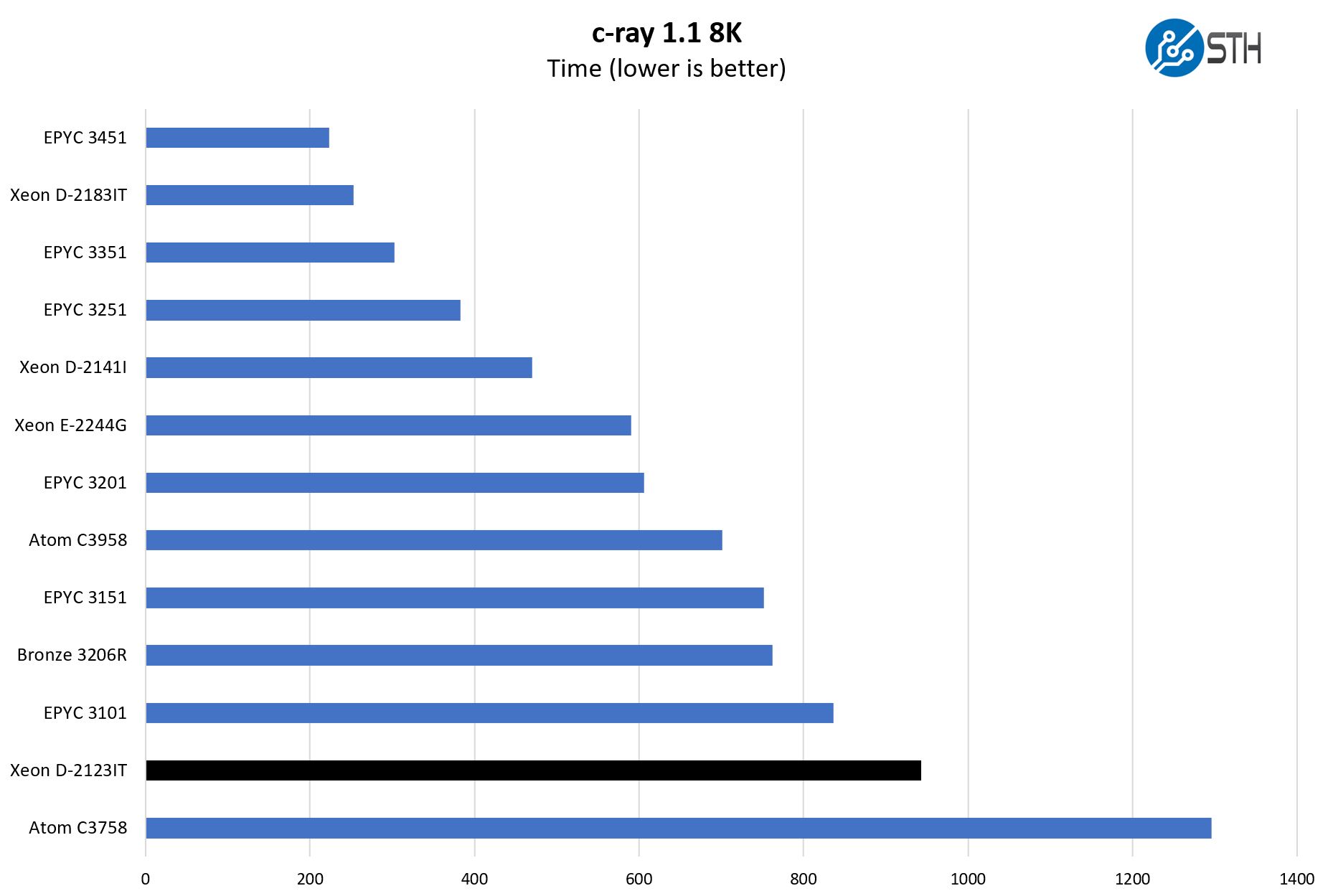
This benchmark is one where AMD does particularly well. This is not one that we would advise our readers to dwell on for too long. Instead, we just wanted to call out the fact that there are some cases where the AMD chips perform particularly well.
7-zip Compression Performance
7-zip is a widely used compression/ decompression program that works cross-platform. We started using the program during our early days with Windows testing. It is now part of Linux-Bench.
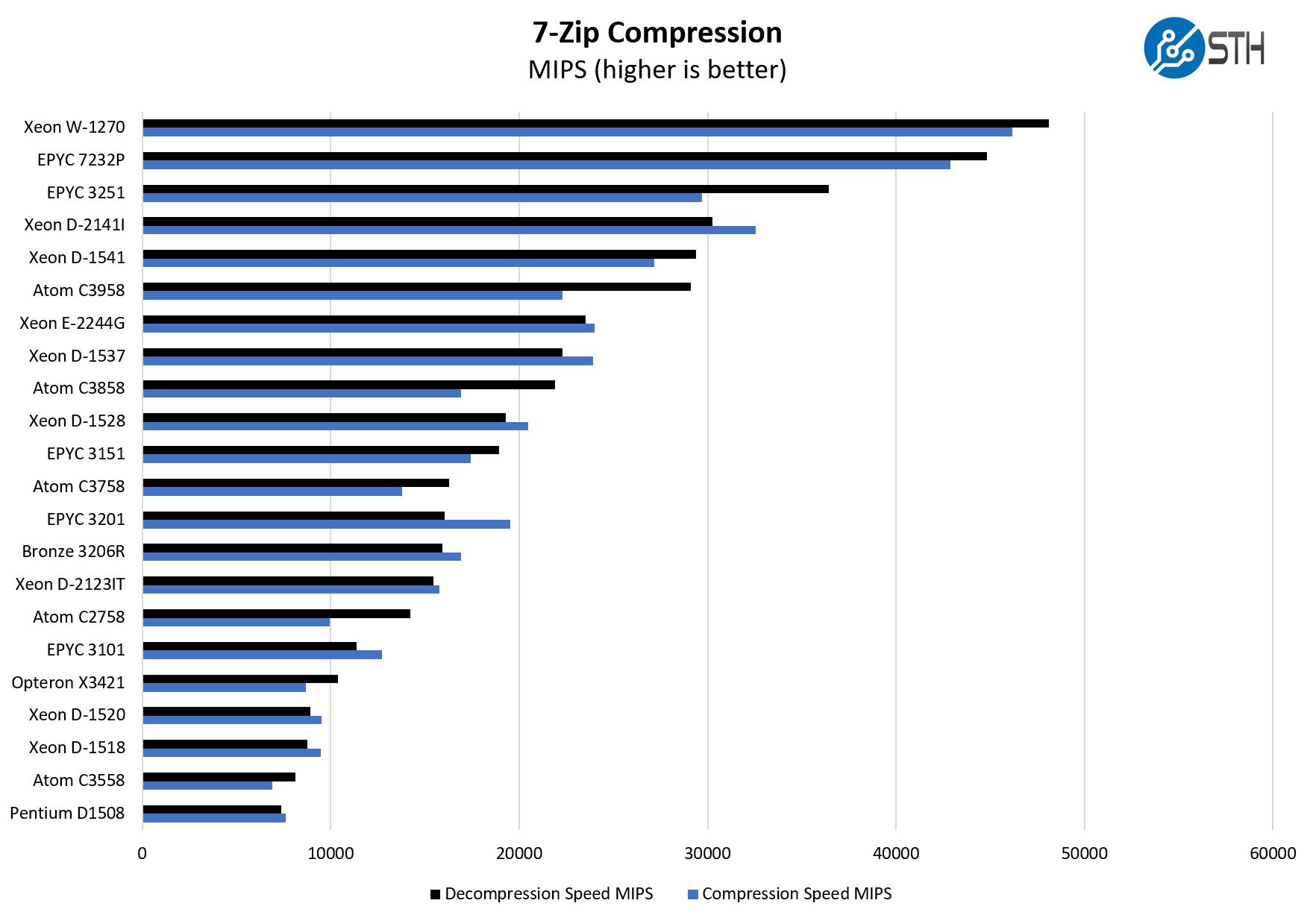
Here we wanted to highlight performance that was close to and often better than the Intel Atom C3758. The 4 core/ 8 thread configuration with the larger cores means we get more performance than eight smaller cores.
NAMD Performance
NAMD is a molecular modeling benchmark developed by the Theoretical and Computational Biophysics Group in the Beckman Institute for Advanced Science and Technology at the University of Illinois at Urbana-Champaign. More information on the benchmark can be found here. With GROMACS we have been working hard to support Intel’s Skylake AVX-512 and AVX2 supporting AMD Zen architecture. Here are the comparison results for the legacy data set:
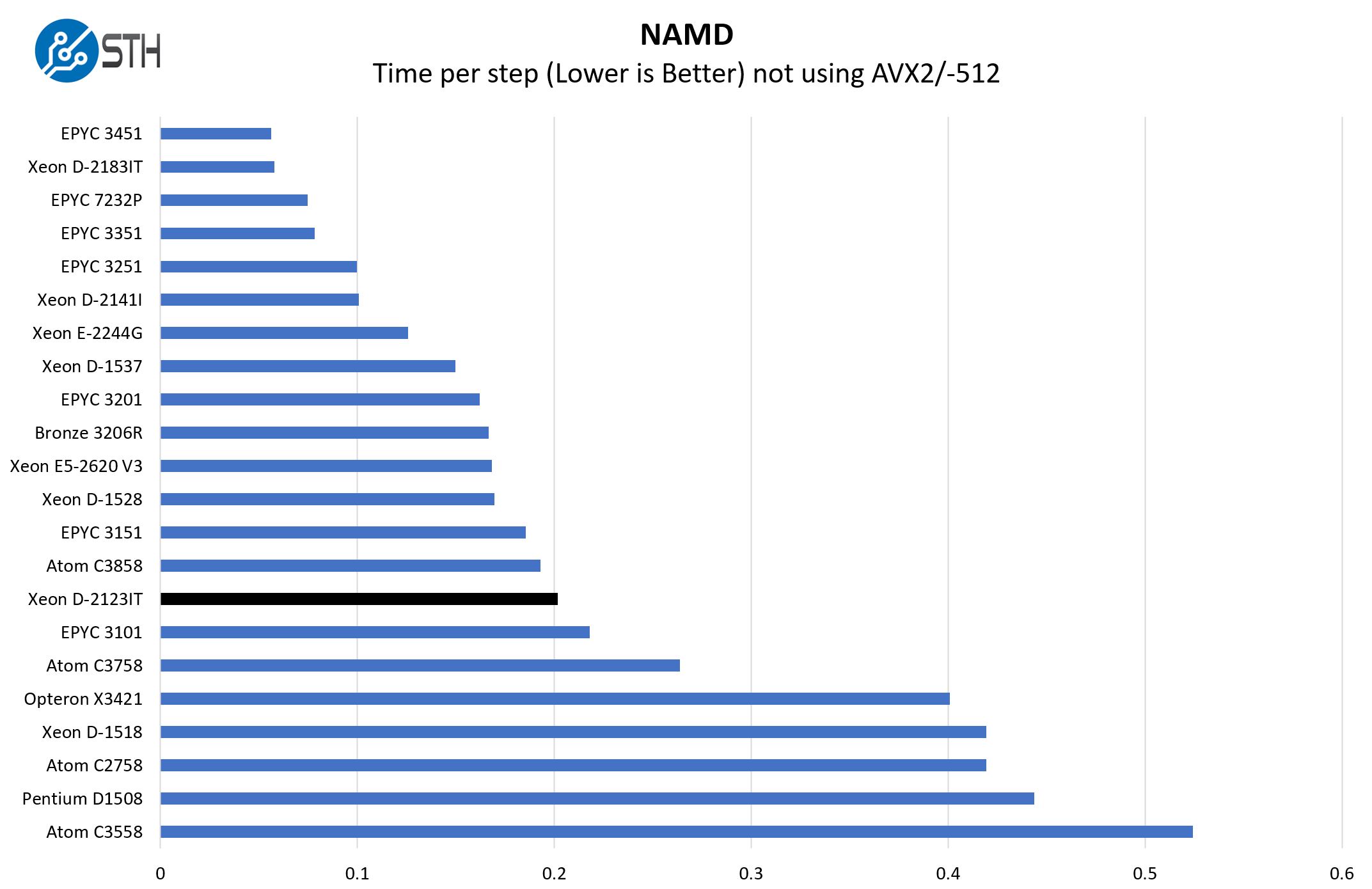
Here again, we can see solid results. AVX-512 is a big feature here, so the picture changes quite a bit as we move to GROMACS later. The other interesting aspect here is that the performance is relatively close here to an 85W 6C/12T Intel Xeon E5-2620 V3 that does not have an integrated PCH. We are getting much higher performance per watt and performance per core with the newer SoCs than the older Haswell/Broadwell architectures.
OpenSSL Performance
OpenSSL is widely used to secure communications between servers. This is an important protocol in many server stacks. We first look at our sign tests:
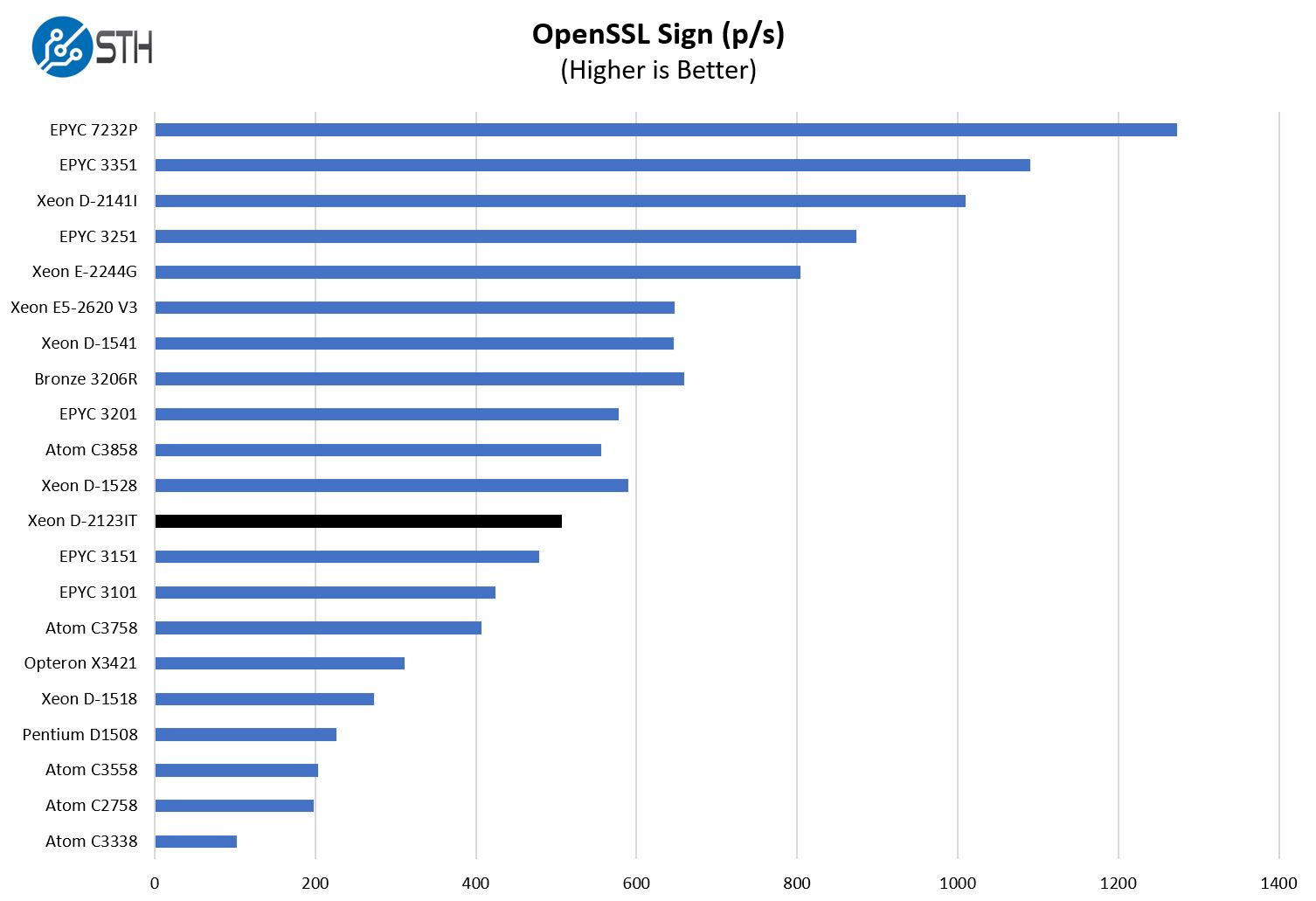
Here are the verify results:
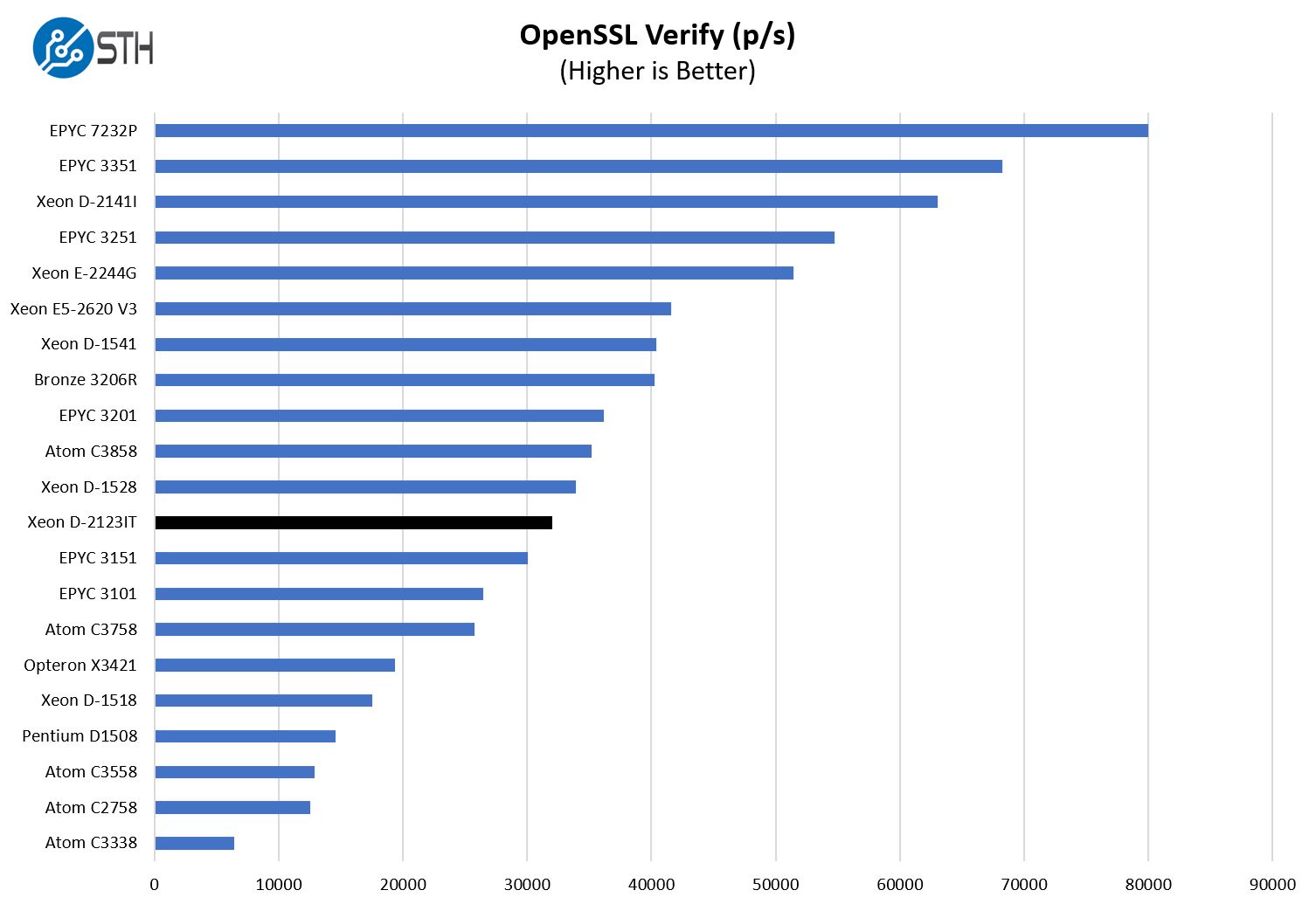
We traditionally sort by the verify results which is why the sign chart looks a bit different. Still, we can see that we are a bit ahead of the 4C/ 8T AMD EPYC 3151 here and well ahead of the 4C/ 8T Intel Xeon D-1518.
UnixBench Dhrystone 2 and Whetstone Benchmarks
Some of the longest-running tests at STH are the venerable UnixBench 5.1.3 Dhrystone 2 and Whetstone results. They are certainly aging, however, we constantly get requests for them, and many angry notes when we leave them out. UnixBench is widely used so we are including it in this data set. Here are the Dhrystone 2 results:
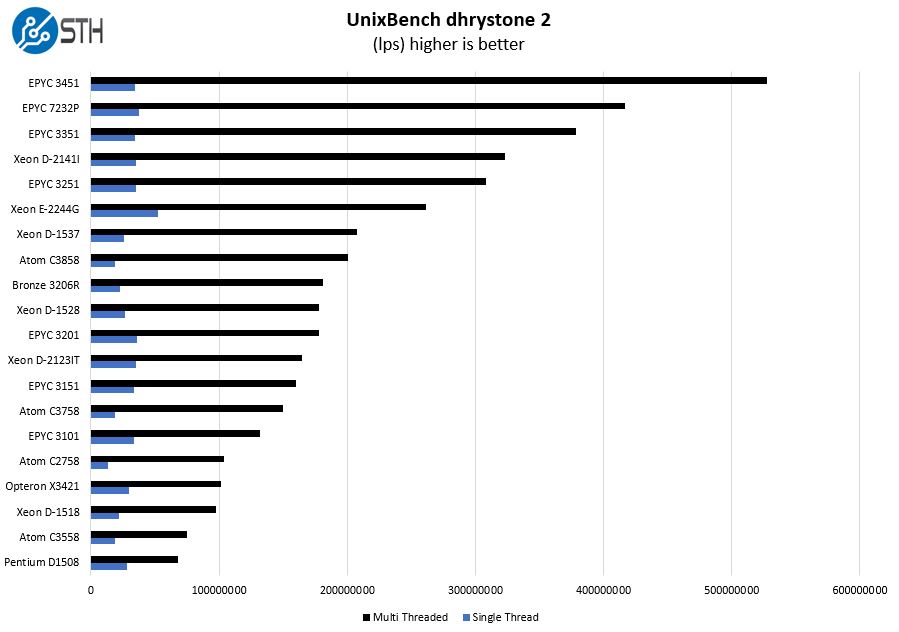
Here are the whetstone results:
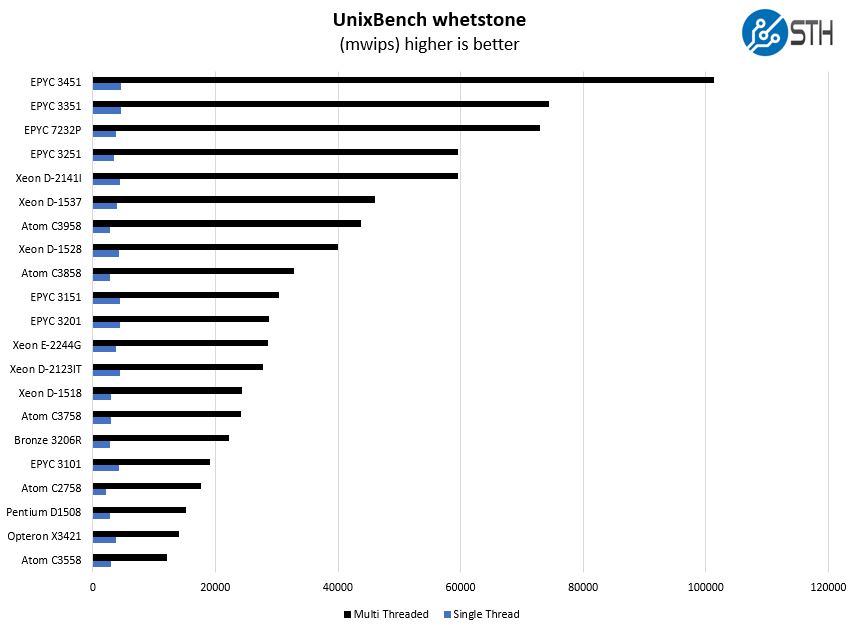
This is a workload where we have a huge data set on, but we are not showing it as much in our more recent reviews. Perhaps the key takeaway here is if we look at the single-threaded results which almost form three groups. High-clock speed parts such as the Xeon E-2244G do very well in that test. There are a number of lower-performance chips such as the Atom CPUs that have lower performance per core but get performance from having more cores. Then the Xeon D-2123IT is in a mid-range group. There are applications that specifically work well on scaling to many lower-speed cores and so that is a popular segment.
GROMACS STH Small AVX2/ AVX-512 Enabled
We have a small GROMACS molecule simulation we previewed in the first AMD EPYC 7601 Linux benchmarks piece. In Linux-Bench2 we are using a “small” test for single and dual-socket capable machines. Our medium test is more appropriate for higher-end dual and quad-socket machines. Our GROMACS test will use the AVX-512 and AVX2 extensions if available.
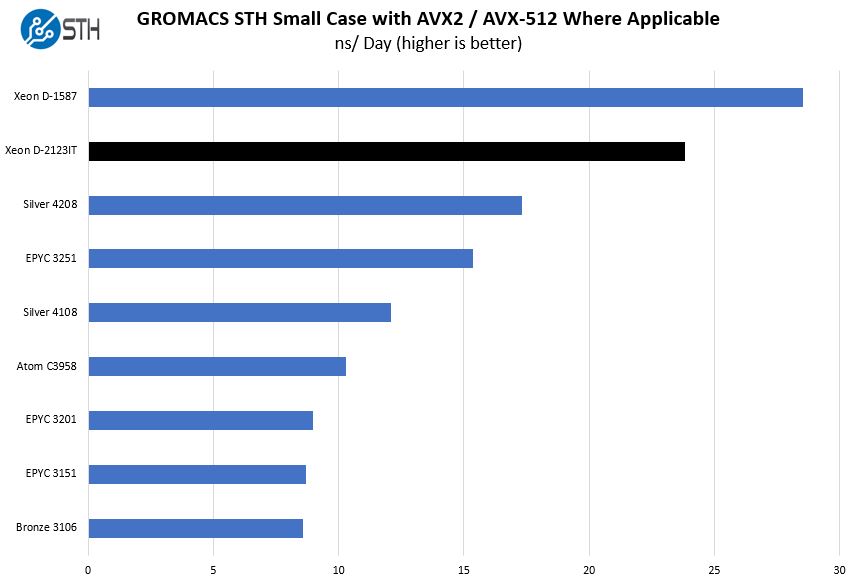
This is always one of the more interesting results. Intel maintains that the Xeon D-2100 series has a single FMA AVX-512 implementation just like the Intel Xeon Silver 4100/ 4200 series. Consistently we see in applications that are AVX-512 enabled that it performs extremely well, significantly better than even the 8 core/ 16 thread Intel Xeon Silver parts. We confirmed this again around the time of the Cascade Lake launch with Intel. This is a great example of where a specific acceleration feature can make a chip leapfrog options that do not have the same feature.
Chess Benchmarking
Chess is an interesting use case since it has almost unlimited complexity. Over the years, we have received a number of requests to bring back chess benchmarking. We have been profiling systems and are ready to start sharing results:
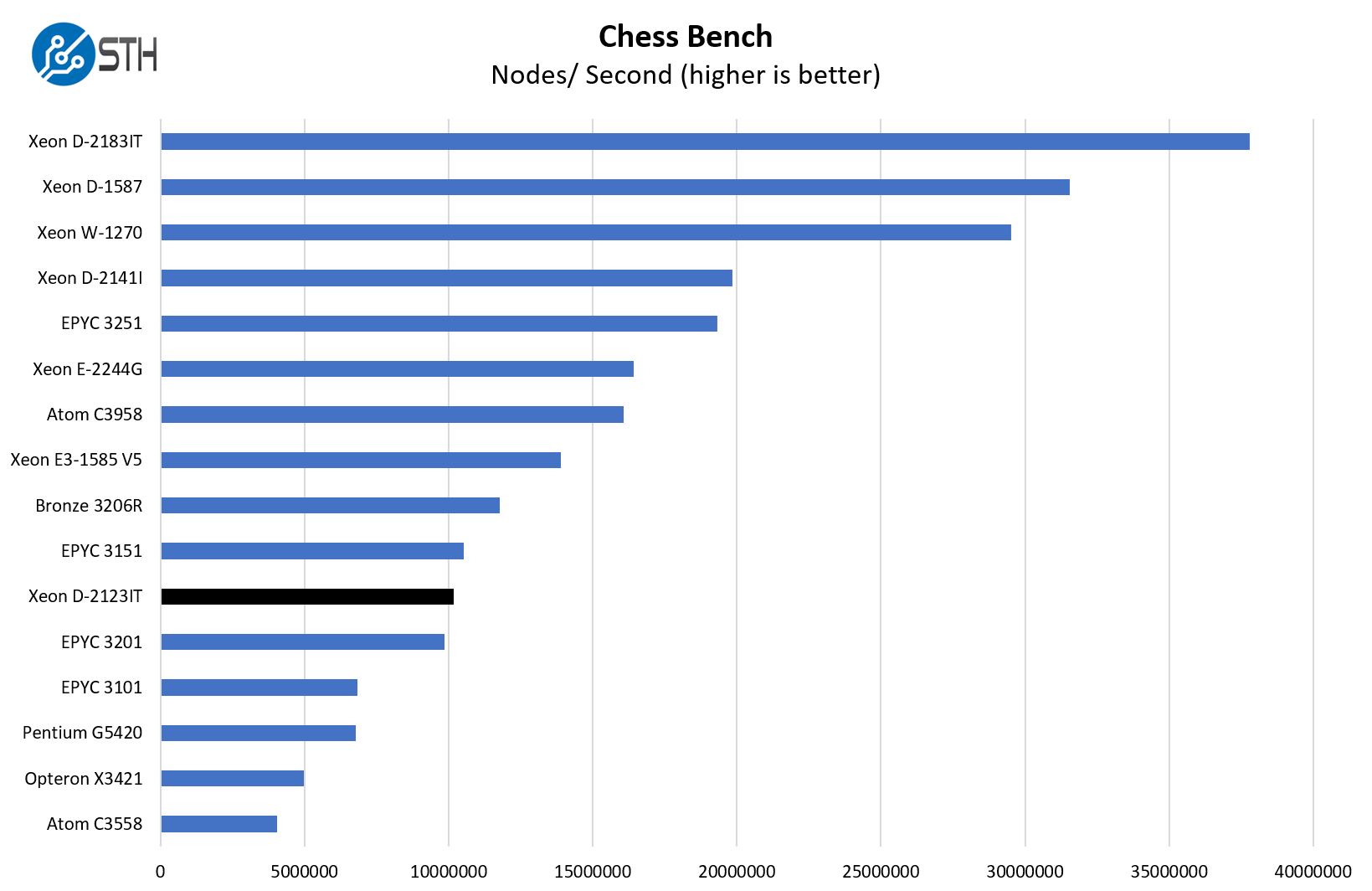
The chess benchmarking shows a lot of the same. Some may notice that we use the Intel Xeon Bronze 3206R in many of these charts. In our view, this is the lowest-end 2nd Gen Intel Xeon Scalable Refresh part so it may be one some segments are tempted to run as the low-end mainstream Xeon server solution which is why we wanted to include it here.
Next, we are going to have power consumption, market positioning, and our final words.
Intel Xeon D-2123IT Power Consumption
We had this chart in the same platform which shows power consumption of various 4 core and 16 core Intel embedded CPU options. We used the same Supermicro motherboard for the Xeon D-2123IT results here:
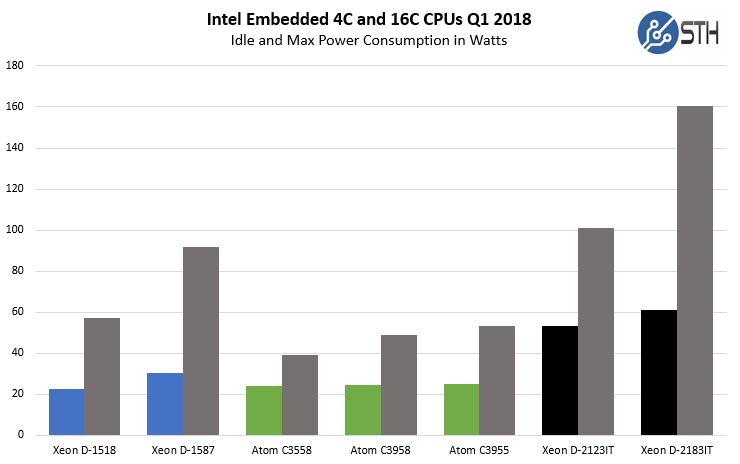
Hopefully, this helps in terms of putting performance, power, and features into a broader perspective in terms of the embedded CPU lines as well as the lower and higher-end configurations of each.
Intel Xeon D-2123IT Market Positioning
The Intel Xeon D-2123IT is in the market alongside the rest of the Intel Xeon D-2100 family (until Ice Lake-D arrives). Here is what the launch family looks like from our Intel Xeon D-2100 Series Initial SKU List and Value Analysis:
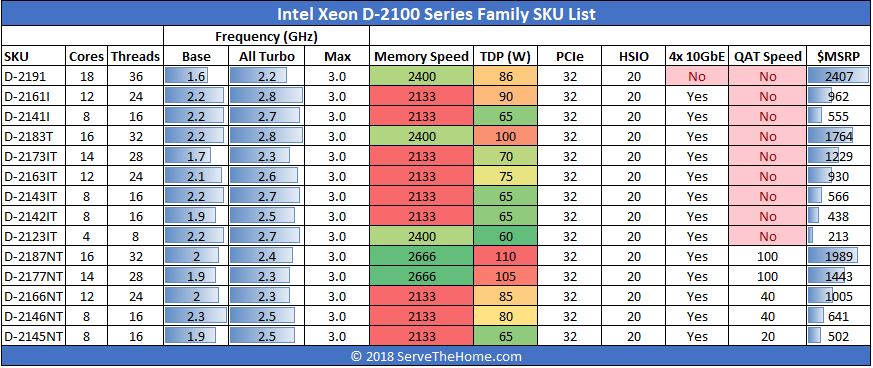
As you can see, this is the lowest-end part in the family. We get a cost that is less than half of the Xeon D-2142IT yet we still get higher clock speeds both for memory clocks as well as for base and all core turbo clocks that help to mask some of the performance delta. More importantly, the Xeon D-2123IT effectively plays the “light the platform” role in the lineup. In most CPU lines there is a basic SKU that serves mostly for applications that need a specific platform but do not need huge core counts. That is the role of the Xeon Bronze series as an example. This is exactly what the Xeon D-2123IT offers here.
Beyond the Intel D-2100 series, the Atom C3000 line can mostly offer the same levels of multi-thread performance with more cores. The Intel Xeon D-1500 and D-1600 series only has dual-channel memory and still uses some legacy PCIe Gen connectivity. The AMD EPYC 3000 line is interesting. The EPYC 3000 is in many ways like an upgraded Xeon D-1500 series with dual-channel memory in the 4-8C segment but more modern PCIe I/O. The larger chips such as the AMD EPYC 3451 have quad-channel memory but one needs to move to more expensive dual-die parts to get to that performance level. While AMD can claim similar 10GbE NIC counts, the challenge is that the AMD EPYC 3000 NICs do not support features such as SR-IOV which is why we often do not see them used. In contrast, the Xeon D-2100 series is using the IP that is in the Lewisburg PCH which is a higher-end solution.
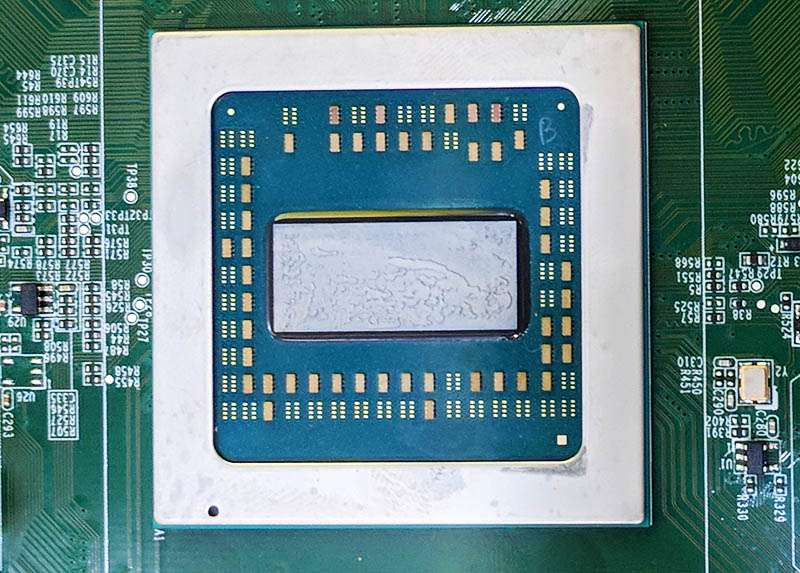
Another interesting way to look at the Xeon D-2123IT is that it is a $75-100 Intel PCH mated with a 4 core CPU for only $213.
Beyond the x86 ecosystem, there are a number of Arm vendors such as NXP that are focusing on this space. In the coming generations, this is going to be a bigger story. Intel is positioning this chip slightly differently since it is effectively the same Skylake core run in one’s data center but in an embedded form factor making code portability trivial. Again, in future generations, this will change, and there is a large segment of the embedded market where everything is custom so Arm is competing, but the design philosophy of Intel in many ways dictates its competitive set.
Final Words
This is likely a review that we should have had on STH earlier when we first covered the chip. Still, embedded lifecycles are long and this is the current-generation Intel part in the space making it highly relevant. The Xeon D-2100 series did not benefit from the 2nd Generation Intel Xeon Scalable refresh pricing and updated “U” series SKUs for single-socket applications. On a raw compute basis, this is a better value than most of the rest of Intel’s line. For a simple “light the platform” part, it performs well and is a great firewall/ storage appliance SKU.

Higher-end Xeon D-2100 series parts for compute applications are much harder to justify these days. For the embedded market, just having BGA mounting and the integrated PCH functionality for a smaller package is extremely important. Still, the Xeon D-2123IT brings that packaging benefit alongside performance that is competitive with the Xeon Bronze series that give it overlap in these “light the platform” type scenarios where I/O connectivity is more important than massive amounts of compute power.
At the outset of testing the Xeon D-2123IT, this was seen as a lower-end part. These days, we look at it as perhaps the best value Xeon D-2100 series part on the market. That just shows there is a lot that can happen over the course of a product cycle.




Thanks for sharing this and for your perspectives. Currently running a Xeon D 1521 based Supermicro based X10SDV-4C-TLN2F, so it’s great to see what the Xeon D 2xxx series in a price conscious (SOHO server here} context. I love the low power, quiet home server context and it’s thanks to STH that I am on my current Xeon D. Do you feel it’s worth waiting for next gen Xeon D if I want a bit more horsepower or should I consider something like the shiny new X570 Ryzen chipset based boards where I can drop in a Ryzen 5600 / 5800? I host a few game servers on my current system and I can see it’s running at 80-85% utilization sometimes.